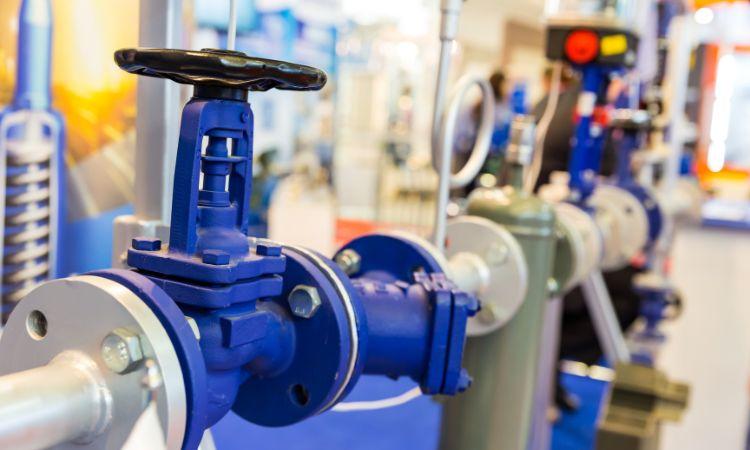The global industrial valves market size reached approximately USD 77.13 billion in 2023. The market is further projected to grow at a CAGR of 4.7% between 2024 and 2032, reaching a value of USD 115.95 billion by 2032. This staggering growth reflects the crucial role that industrial valves play in various sectors, with the oil and gas industry being a significant consumer. Industrial valves are the unsung heroes of the oil and gas sector, as they control the flow of fluids, gases, and materials in various critical processes.
In this comprehensive blog post, we will explore the diverse applications and challenges of industrial valves in the oil and gas industry. We will dive into the various types of valves commonly used, discuss their critical applications, shed light on the challenges faced during valve selection and use, examine the latest innovations and trends, and provide real-world case studies to illustrate their importance. Join us on this journey as we unveil the vital role that industrial valves play in the oil and gas industry.
Types of Industrial Valves in the Oil and Gas Industry
Gate Valves
Gate valves are fundamental components in the oil and gas industry, primarily known for their ability to provide a straight-line flow with minimal pressure drop. They are commonly used for on/off control and isolation applications. In drilling operations, gate valves are essential for controlling the flow of drilling mud and other fluids into the wellbore. This prevents blowouts and ensures the safety of the drilling process.
Gate valves are also prevalent in pipeline systems, where they serve as block valves to isolate sections of the pipeline for maintenance or emergency shutdowns. Their robust construction and ability to handle high-pressure and high-temperature conditions make them a reliable choice in the oil and gas sector.
Globe Valves
Globe valves are versatile and find applications in various oil and gas processes, especially when precise flow control or throttling is required. These valves are characterized by a globe-shaped body and a movable plug or disc that can be positioned to regulate the flow rate. Globe valves are commonly used in refining and processing facilities to control the flow of crude oil, gases, and other hydrocarbons.
Their ability to provide fine-tuned control makes them valuable in maintaining the desired pressure and flow rates within the system. In addition to their use in refining, globe valves are also found in gas distribution networks, ensuring safe and efficient gas supply to consumers.
Ball Valves
Ball valves are known for their quick and reliable shutoff capabilities, making them indispensable in critical applications in the oil and gas industry. These valves consist of a spherical ball with a hole through it, which can be rotated to allow or block the flow of fluids. Ball valves are widely used in pipeline systems for their ability to provide tight shutoff, preventing leakage of hazardous substances.
In the oil and gas sector, ball valves are commonly employed in the transportation of hydrocarbons, including natural gas and crude oil. Their low maintenance requirements and durability in high-pressure environments make them a preferred choice.
Butterfly Valves
Butterfly valves are appreciated for their cost-effectiveness and ease of operation. They have a disc that rotates on an axis perpendicular to the flow, allowing for quick opening and closing. In the oil and gas industry, butterfly valves are used for flow control, especially in large-diameter pipelines.
One of the primary applications of butterfly valves is in storage tanks and terminal facilities, where they control the flow of crude oil and other petroleum products during loading and unloading processes. Their lightweight design and ability to handle large flow volumes make them suitable for such applications.
Critical Applications of Industrial Valves in the Oil and Gas Sector
Wellhead and Drilling Operations
In wellhead and drilling operations, the integrity and reliability of valves are of paramount importance. Valves are used to control the flow of drilling mud, cement slurries, and other fluids into the wellbore during drilling processes. Additionally, they play a crucial role in managing pressure and preventing blowouts, which can have catastrophic consequences.
Gate valves, in particular, are preferred for wellhead applications due to their ability to provide quick shutoff in emergency situations. Properly functioning valves are essential for maintaining wellbore stability and ensuring the safety of drilling personnel.
Pipeline Transportation
Pipeline transportation is the lifeblood of the oil and gas industry, enabling the efficient movement of hydrocarbons from production facilities to distribution points. Valves are strategically placed along the pipeline network to regulate the flow, isolate sections for maintenance, and control pressure.
In this context, gate valves and ball valves are commonly used as block valves to isolate segments of the pipeline. Ball valves, in particular, are favored for their ability to provide a bubble-tight seal, preventing leaks and minimizing the risk of environmental damage.
Refining and Processing
Refining and processing facilities are where crude oil is transformed into various petroleum products, including gasoline, diesel, and petrochemicals. Valves are integral to these operations, ensuring precise control over the refining process.
Globe valves are frequently employed in these facilities to regulate the flow of crude oil and other feedstocks. Their fine control capabilities allow operators to maintain optimal process conditions, resulting in higher efficiency and product quality.
Storage and Distribution
Storage tanks and distribution terminals are crucial links in the oil and gas supply chain. Valves are used in these facilities to control the filling and emptying of storage tanks, ensuring safe and efficient operations.
Butterfly valves are well-suited for use in storage tank applications due to their ability to handle large flow volumes. They are used to control the flow of crude oil, refined products, and chemicals during loading and unloading processes.
Challenges in Valve Selection and Use
Extreme Operating Conditions
The oil and gas industry operates in some of the most extreme conditions on Earth. Valves must withstand high temperatures, high pressures, and corrosive environments. Selecting the right materials and designs to handle these conditions is a critical challenge.
Valve manufacturers have responded by developing specialized materials, such as corrosion-resistant alloys and high-temperature ceramics, to ensure the longevity and performance of valves in harsh environments.
Corrosion and Erosion
Corrosion and erosion are constant threats to valves in the oil and gas sector, especially when dealing with aggressive media or abrasive substances. Corrosion can weaken valve components and lead to leaks, while erosion can cause damage to valve surfaces and affect their functionality.
To combat these challenges, engineers and manufacturers have adopted coatings and materials that are highly resistant to corrosion and erosion. Additionally, regular maintenance and inspection protocols are essential to detect and address issues promptly.
Safety and Environmental Considerations
Safety and environmental concerns are paramount in the oil and gas industry. Any valve failure or leakage can lead to catastrophic accidents, harm to personnel, and significant environmental damage. Ensuring the integrity and leak-tightness of valves is, therefore, a top priority.
Stringent testing and quality control measures are in place to certify valves for use in hazardous environments. Valve manufacturers adhere to industry standards and regulations to minimize the risk of leaks and ensure the safety of operations.
Compliance and Regulatory Requirements
The oil and gas industry is subject to various national and international regulations aimed at protecting the environment, ensuring safety, and maintaining industry standards. Valves used in this sector must comply with these regulations.
Valve manufacturers invest in research and development to produce compliant products, and operators must ensure that valves installed in their facilities meet the necessary regulatory requirements. Non-compliance can result in legal and financial consequences.
Innovations and Trends in Industrial Valves for Oil and Gas
Introduction to Technological Advancements
The oil and gas industry is no stranger to technological advancements, and industrial valves have not been left behind. One notable trend is the development of smart valves, which are equipped with sensors and communication capabilities. These valves can provide real-time data on their status and performance, allowing for predictive maintenance and remote monitoring.
Smart valves are increasingly adopted in critical applications, as they enhance safety and reduce downtime. They enable operators to detect potential issues before they lead to valve failure or leaks, thereby preventing accidents and minimizing production disruptions.
Environmental Considerations
In response to growing environmental concerns, the oil and gas industry is placing a greater emphasis on reducing emissions and minimizing its carbon footprint. Valves are a part of this effort, with the development of low-emission valves that help mitigate fugitive emissions of greenhouse gases.
Low-emission valves are designed with advanced sealing technologies to reduce the escape of volatile organic compounds (VOCs) and other pollutants. These valves contribute to environmental sustainability while still maintaining their critical functions in the industry.
Automation and Remote Monitoring
Automation is a driving force in the oil and gas industry, and valves are no exception. Automated valve systems, often integrated into larger control systems, allow for precise control and rapid response to changing conditions.
Remote monitoring capabilities further enhance the efficiency and safety of valve operations. Operators can monitor valve status, receive alerts, and make adjustments remotely, reducing the need for on-site personnel and improving overall operational efficiency.
Materials and Coatings
Advancements in materials science and coatings have led to the development of valve components that are more durable and resistant to extreme conditions. Materials like nickel-based alloys and specialized coatings can significantly extend the lifespan of valves in corrosive environments.
These materials and coatings not only enhance valve performance but also reduce maintenance requirements and associated costs, making them a cost-effective choice for the industry.
Read More Articles
ammunition manufacturers in usa
Case Studies
Case Study 1: Offshore Oil Platform
In this case study, we examine how industrial valves play a critical role in ensuring the safe and efficient operation of an offshore oil platform. Gate valves are used at various points in the platform’s production and processing systems to control the flow of oil and gas. The case study highlights how proper valve selection, maintenance, and compliance with safety regulations contribute to the platform’s success.
Case Study 2: Oil Refinery
This case study takes us inside an oil refinery where globe valves are used to regulate the flow of different hydrocarbon streams during the refining process. We explore how precise control over the flow rates and pressures is achieved using globe valves, leading to increased efficiency and the production of high-quality petroleum products.
Case Study 3: Natural Gas Pipeline
In our third case study, we focus on a natural gas pipeline and the critical role of ball valves in ensuring the safe and efficient transportation of natural gas over long distances. We delve into the challenges of maintaining tight shutoff in high-pressure gas pipelines and how ball valves address these challenges effectively.
Conclusion
The global industrial valves market is poised for substantial growth, with the oil and gas industry being a major driver of demand. The importance of industrial valves in this sector cannot be overstated, as they control the flow of fluids and gases in critical applications that impact our energy supply, the environment, and safety.
From gate valves in wellhead operations to globe valves in refining processes, and from ball valves in pipeline transportation to butterfly valves in storage facilities, each type of valve serves a specific purpose in the oil and gas industry. These valves must meet the challenges of extreme operating conditions, corrosion, safety regulations, and environmental concerns.
As we move forward, innovations such as smart valves, low-emission valves, and advanced materials will continue to shape the industry. The oil and gas sector will remain at the forefront of technological advancements, and industrial valves will play an increasingly vital role in ensuring its continued success.
In conclusion, the growth of the industrial valves market is intrinsically linked to the growth of the oil and gas industry. As the demand for energy continues to rise, so does the demand for reliable and efficient valves. By understanding their diverse applications, addressing the challenges, and embracing innovation, the oil and gas sector can continue to rely on industrial valves as the backbone of its operations, ensuring the safe and efficient flow of hydrocarbons around the world.



